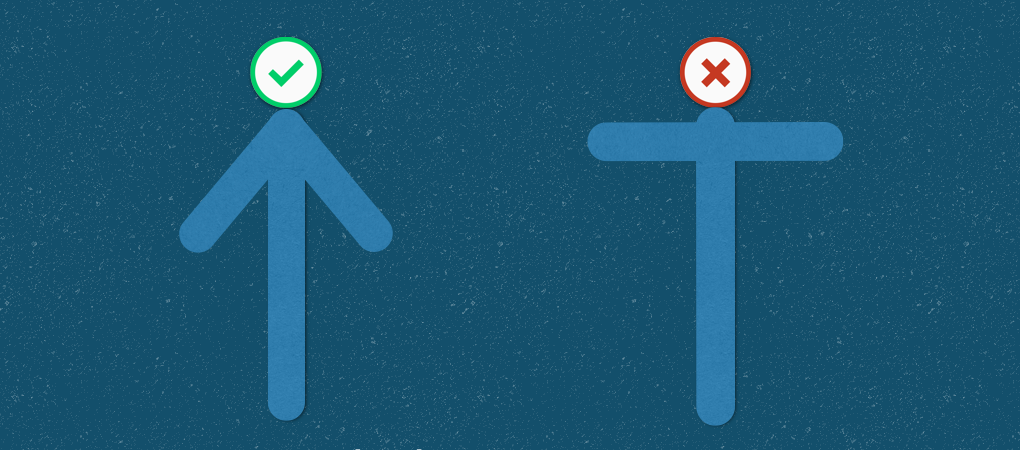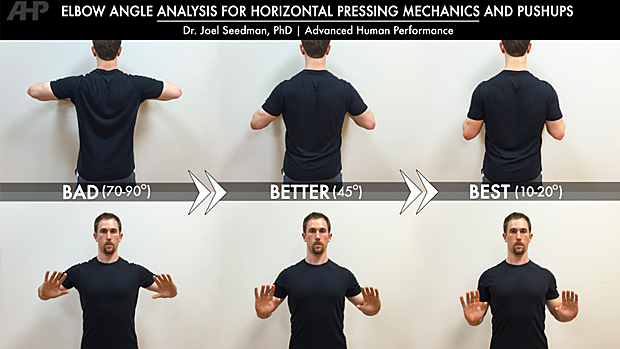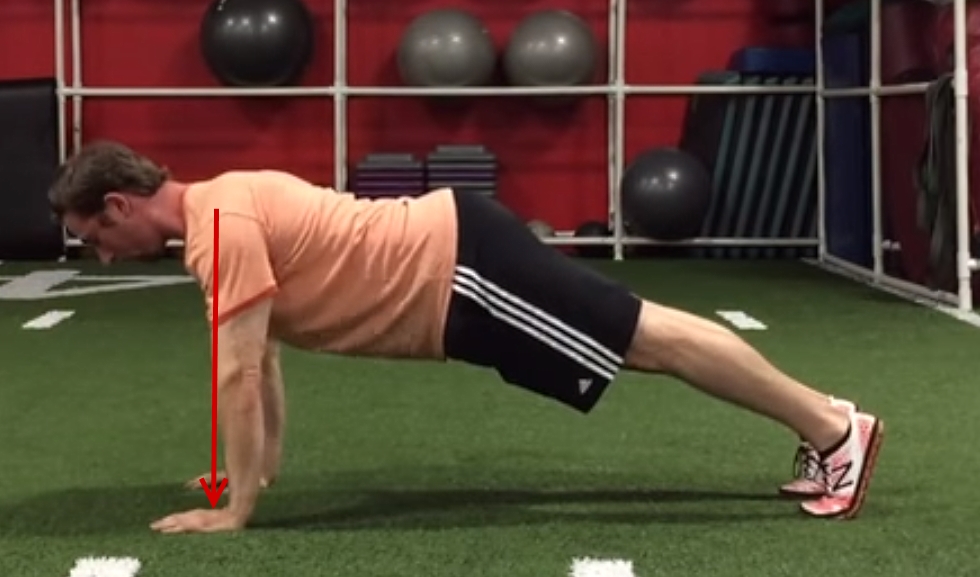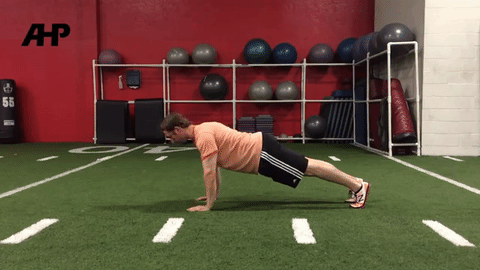The push-up is the mother of all bodyweight exercises. You can do it anywhere and anytime and it targets many muscle groups. That’s why gym teachers and army instructors love it so much. The push-up is also a particularly varied exercise; by performing the exercise differently, you can make her heavier and lighter or put the emphasis on a different muscle group.
PUSH UP VS BENCH PRESS
The push-up is a compound exercise for the entire front of your torso (chest, shoulders and arms – especially the triceps). One that fits well into your chest workout, even though the prelude will usually be the bench press.
The push-up is sometimes compared to a ‘reverse bench press’. That comparison is quickly flawed. For example, there is an essential difference between pushing a weight away from you (bench press) and an exercise in which you are the weight yourself (push-up). The push-up is not a bench press, for the same reasons a pull-up is not a pulldown. Albert Einstein would probably try to convince us that this is just a matter of perspective and theoretically he would be right, but in practice there is a difference.
However, the differences between push-up and bench press go beyond perspective. Unlike the bench press, the push-up does not support your body and the exercise explicitly calls on your waist, ie your abdomen and lower back. Both act as stabilizers. Without a strong means, you can forget about a correct execution of the push-up. In addition, your quadriceps should keep your legs straight. Basically, the push-up is a bench press and plank (static exercise for your waist) in one.
Another difference between the two classics is that the bench press (whether you do it with a barbell or with dumbbells) activates the pectoralis major more than the push-up. The question is, however, whether the difference is as great as often thought. EMG-examination in 2012 shows that the push-up the chest muscle in fact only 61% will activate with respect to the bench press (100%). However, EMG research says nothing about the actual muscle growth. Strength and muscle size were measured in a 2017 study that found the bench press for the chest and triceps to be only slightly more effective than the push-up.
The push-up therefore seems to be a great alternative to the bench press, especially if you are forced to train at home and have little training material available. But the push-up is also a full-fledged exercise in a regular training program that you can do in addition to the bench press. And you can make the push-up harder in all kinds of ways (see below), if the regular version has become too easy for you.
EXECUTION
No matter how simple the push-up may seem, the exercise is all too often performed sloppily or incorrectly, whether or not to achieve as many repetitions as possible. Put that quantitative aspect out of your mind and focus on quality. The push-up is a serious exercise for strength and muscle mass, and incorrect execution will detract from its effectiveness and can even cause shoulder injuries. We will go through the most important aspects of the implementation below.
1. HANDS AND ARMS
Often the the hands are placed too high and the elbows out. That makes the exercise easier. However, we don’t want an ‘easy’ exercise, but an effective one. And safety is also a reason to do it differently. Placing elbows outwards is extremely taxing on your shoulder joint.
To determine the correct position of your hands and arms, it is best to view the push-up from the air. In a drone perspective, so to speak. The just outlined ‘easy’ position then looks like the letter T. However, the desired position looks like an arrow. So like this:

So place your arms a little closer to your body and a little further back, so that your upper arms make an angle of 45 to (preferably) 20 degrees instead of 90 degrees with your torso. This relieves your shoulders and also ensures a more effective execution.
 Place your arms close to your body and back so that your upper arms are at a 45 to (preferably) 20 degree angle to your torso instead of 90 degrees. ( T Nation: Dr. Joel Seedman ).
Place your arms close to your body and back so that your upper arms are at a 45 to (preferably) 20 degree angle to your torso instead of 90 degrees. ( T Nation: Dr. Joel Seedman ).Looking at this from the side, there should be a more or less straight line from the shoulder to the lower part of the hand:

At the front we see the hands, in a regular push-up, are just a little further than shoulder width:

Placing the hands further apart or closer together is also possible, but then you shift the focus of the exercise to the chest or triceps. We will discuss push-ups for the triceps further on.
Regardless of the positioning of your hands, keep your elbows back and not out.
Your hands are not completely flat on the floor (some space remains under your palms). This also contributes to correct positioning of your arms and elbows. The fingers point straight ahead.
2. FEET
Basically you put your feet together. Beginners sometimes put them apart, which makes the exercise less strenuous. How far back you place your feet is rather a matter of experimenting with what feels best for you. You figured that out during the first few reps. The point here is that you can perform the exercise completely straight, in the ‘arrow position’ just described.
3. NECK
Prevent pain in your neck by keeping it in a neutral position, i.e. in line with your spine. Don’t pull your chin to your chest or look straight ahead. Instead, during the exercise, keep looking at a point several tens of centimeters in front of you.
4. THE MOVEMENT
Push yourself up by fully extending your arms, keeping your body completely straight at all times by keeping your muscles constantly tense (even in the lowest position). By ‘straight’ we mean a straight connection between the head, shoulders, hips, knees and ankles. The hips may be slightly higher than the rest, but certainly not lower! Remember: the lower the hips, the ‘nappy’ the push-up. See also ‘Back’, under point 8.
Pause for a split second and now come back down by bending your arms. Repeat for desired number of repetitions.

5. BREATHING
The general rule of strength training is: exhale when you lift a weight and inhale when you lower the weight. For the push-up therefore applies; inhale as you descend through your arms and exhale as you push yourself back up.
6. RANGE OF MOTION (ROM)
A push-up is only a push-up if or hips and chin or nose touch the floor at the same time! Okay, fair is fair. Some will be in favor. We mean people with a pronounced chin or nose. Either way, a push-up is always all the way up, all the way down.
7. BACK
Many people arch their backs enormously, or they let their lower body hang slightly. As a result, in the downward motion, the hips are already touching the floor when the arms are just bent. This is how you do, as we said, “lazy” push-ups, also known as “girl push-ups” – no offense, ladies.
The correct posture is basically the plank stance: flat, but with a natural curve that follows your spine and with the hips up to a fraction higher than the rest of your body. In addition, squeezing your buttocks excessively, as is often advised, is not necessary.
9. SHOULDER BLADES
The shoulder blades should move around the rib cage throughout the exercise. When lowering your body, your shoulder blades should be squeezed together. When going up, they just move apart. In both cases you push them down and not up. You achieve this by moving your shoulders back towards your feet during the exercise, instead of pulling them up towards your ears. A ‘chest out’ attitude, in fact.
10. PACE
We prefer a 1-0-2 pace. That is, the concentric phase lasts one second and the eccentric phase two seconds, with no significant pause (that’s what we meant by a fraction of a second). To put it more simply: press yourself up explosively, hold the stretched position for a moment and come back down in two seconds in a controlled manner.
We rarely see push-ups performed in this correct way. Perhaps your form has been anything but perfect until now and you will discover that the push-up as it is intended is a lot heavier!
HOW TO MAKE PUSH-UPS HARDER
Can you do more than 15-25 reps in a row now? Then it is time to make the exercise more difficult. Because if muscle growth is your goal, doing your thirty or forty press-ups in a row won’t do you much good. After all, the growth stimulus mainly resides in the roughly last five repetitions before muscle failure (the so-called effective repetitions), because only then is sufficient of the mechanical tension necessary for muscle growth.
You can make push-ups harder by lowering yourself a little more slowly, for example, and/or by pausing at the bottom and/or by placing your hands more back.
 Throw in more and more of your body weight. (Source: YouTube/Jeremy Ethier )
Throw in more and more of your body weight. (Source: YouTube/Jeremy Ethier )Another option is to increase the resistance by carrying a heavy backpack during the exercise. Or by doing her with a resistance band, if you have one.
 Extra resistance with the help of a filled backpack or a resistance band. (Source: YouTube/Jeremy Ethier )
Extra resistance with the help of a filled backpack or a resistance band. (Source: YouTube/Jeremy Ethier )Finally, you can use push-up grips. These increase the range of motion of the exercise (the range of motion) and thus the training stimulus.
PUSH-UP VARIANTS
There are countless variations on the conventional push-up. These make push-ups even harder and with some you emphasize certain muscle groups, such as the chest.
With asterisks we have indicated the level of difficulty compared to standard push-ups (**).
1. DIAMOND PUSH UP *
The diamond push-up differs from the standard push-up in the position of the hands: instead of next to each other at shoulder width, as with a normal push-up, your hands are close together (not against each other) and so to turned towards each other so that they form more or less a diamond.
This hand position reduces the activity of the shoulders, in favor of the chest and triceps. So if you mainly want to train your chest and triceps with push-ups, this is your variant.
2. DECLINE PUSH UP ***
The decline push-up is the heavier counterpart of the incline push-up. You do not place your hands, but your feet on an elevation, which makes the exercise a lot heavier than the regular push-up. To be precise (namely according to American research): 9 percent heavier by putting your feet on an elevation of roughly thirty centimeters, 15 percent heavier with an elevation of about sixty centimeters.
With decline you also activate your upper chest muscles and the front shoulders a bit more. Note that these muscle regions are activated less with decline bench press or chest fly.
All in all, the decline push-ups are a great exercise for when the regular push-up offers too little challenge.
4. ONE LEG PUSH UP ***
In this version you keep one leg (two is so difficult) in the air, so that you are not supported on four, but on three points. This means that your stabilizers (abs, lower back) have to work much harder.
You can switch from rep to rep or leg set as desired.
5. ARCHER PUSH UP ****
With an archer push-up you don’t drop straight down like a regular push-up, but you shift the weight to one arm. That way you can use a higher percentage of your body weight per arm, while the other arm still participates a bit. It is therefore a lighter version of the one-armed push-up (see 6), but for many it is already hard enough.
6. ONE-ARM PUSH-UP *****
If you ‘ve seen Rocky, you’ll know how to do this variation: with your feet fairly wide apart for better balance and one arm on your back (or wherever you want to keep it, as long as it’s not on the floor) ). It can help to place your arm a little further in than with a conventional push-up, so at shoulder width instead of slightly wider.
Mind you, one-armed push-ups are very heavy and really only suitable for practitioners of calisthenics, people who train frequently with their own body weight and who are extremely strong in relation to that body weight.
7. PIKE PUSH UP**
The pike push-up is a variation of the shoulder press. So you shift the accent to the fronts of your shoulders. Handy for when you have to train at home but have too little resistance to do the shoulder press.
In the pike push-up, you initially assume a normal push-up position, with your hands slightly wider than shoulder width. Then bring your hands closer to your feet. The distance depends on your experience, because the closer your hands and feet are together, the harder the exercise. Reducing that distance is therefore a way to make progress when it no longer makes sense with the number of repetitions. But you can also place your feet on an elevation to make the exercise (even) heavier.
8. CLAPPING PUSH UP****
Clapping pushups are a plyometric exercise, aimed at increasing your explosiveness, rather than your strength (although the two are related, of course). In this variant you press yourself explosively, so that your hands come off the floor. Clap your hands and catch yourself with slightly bent elbows and return to your starting position.
Mind you, it is crucial to reach sufficient height. It is not the intention that you just get off the ground, quickly clap your hands and barely manage to avoid hitting the floor! The really explosive boys (and girls) know how to clap their hands twice. Are you not (yet) explosive enough? Then perform clapping incline push-ups to work on your explosiveness.
9. TRICEPS EXTENSIONS PUSH UP ***
Instead of having your hands flat on the floor, perform this push-up variation with your forearms flat on the floor. You lie on the floor with your arms straight in front of you, with your elbows out so as if you were watching TV while lying on your stomach. Make sure your wrists are level. Now push yourself up.
10. HINDU PUSH UP****
Hindu push-ups, also called tiger push-ups or judo push-ups, do not start with your body straight, but with your body in an inverted V-shape, i.e. with your arms and legs stretched out and your butt in the air. In principle, you now lower your buttocks, making it seem as if you are trying to move your head and shoulders in one smooth movement under an imaginary tensioned wire.
11. SPIDERMAN PUSH UP****
Have you ever seen Spiderman scramble up a wall? Then you already have a vague idea of how to perform a Spiderman push-up. During the negative phase of the movement, i.e. while lowering, move your knee towards your elbow on the same side (not your chest).
FINALLY
The push-up is mistakenly seen as a typical beginner exercise. Or an exercise that you only do when there are no weights available (on vacation for example). Our opinion is that this exercise should not be missing in any training routine, whether beginner or advanced, even if the bench press is part of your routine. The push-up is less of a typical chest exercise like the bench press is, but in our opinion it fits well into any chest workout.
REFERENCES
- https://minds.wisconsin.edu/handle/1793/62857
- http://www.100pushups.com/arm-position/
- https://www.t-nation.com/training/tip-the-worst-way-to-do-push-ups
- https://www.t-nation.com/training/tip-do-this-to-make-push-ups-more-effective
- https://www.t-nation.com/training/strong-traps-healthy-shoulders
- https://youtu.be/IODxDxX7oi4
- https://youtu.be/yXuYJtRkmlM
- http://www.ncbi.nlm.nih.gov/pubmed/21873902